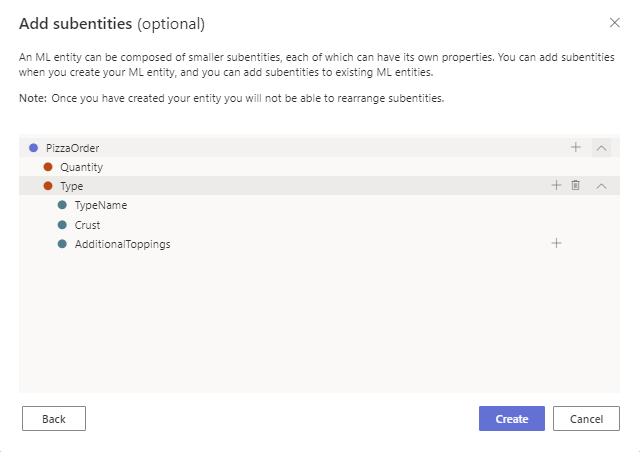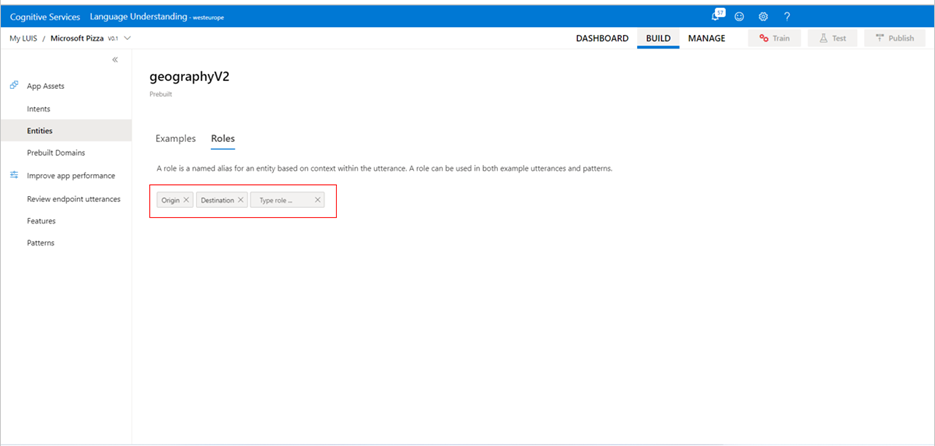Add entities to extract data
Important
LUIS will be retired on October 1st 2025 and starting April 1st 2023 you will not be able to create new LUIS resources. We recommend migrating your LUIS applications to conversational language understanding to benefit from continued product support and multilingual capabilities.
Create entities to extract key data from user utterances in Language Understanding (LUIS) apps. Extracted entity data is used by your client application to fulfill customer requests.
The entity represents a word or phrase inside the utterance that you want extracted. Entities describe information relevant to the intent, and sometimes they are essential for your app to perform its task.
How to create a new entity
The following process works for machine learned entities, list entities, and regular expression entities.
- Sign in to the LUIS portal, and select your Subscription and Authoring resource to see the apps assigned to that authoring resource.
- Open your app by selecting its name on My Apps page.
- Select Build from the top navigation menu, then select Entities from the left panel, Select + Create , then select the entity type.
- Continue configuring the entity. Select Create when you are done.
Create a machine learned entity
Following the pizza example, we would need to create a "PizzaOrder" entity to extract pizza orders from utterances.
Select Build from the top navigation menu, then select Entities from the left panel
In the Create an entity type dialog box, enter the name of the entity and select Machine learned , select. To add sub-entities, select Add structure. Then select Create.
A pizza order might include many details, like quantity and type. To add these details, we would create a subentity.
In Add subentities , add a subentity by selecting the + on the parent entity row.
Select Create to finish the creation process.
Add a feature to a machine learned entity
Some entities include many details. Imagine a "PizzaOrder" entity, it may include "ToppingModifiers" or "FullPizzaWithModifiers". These could be added as features to a machine learned entity.
Select Build from the top navigation bar, then select Entities from the left panel.
Add a feature by selecting + Add feature on the entity or subentity row.
Select one of the existing entities and phrase lists.
If the entity should only be extracted if the feature is found, select the asterisk for that feature.
Create a regular expression entity
For extracting structured text or a predefined sequence of alphanumeric values, use regular expression entities. For example, OrderNumber could be predefined to be exactly 5 characters with type numbers ranging between 0 and 9.
Select Build from the top navigation bar, then select Intents from the left panel
Select + Create.
In the Create an entity type dialog box, enter the name of the entity and select RegEx , enter the regular expression in the Regex field and select Create.
Create a list entity
List entities represent a fixed, closed set of related words. While you, as the author, can change the list, LUIS won't grow or shrink the list. You can also import to an existing list entity using a list entity .json format.
Use the procedure to create a list entity. Once the list entity is created, you don't need to label example utterances in an intent. List items and synonyms are matched using exact text. A "Size" entity could be of type list, and it will include different sizes like "small", "medium", "large" and "family".
From the Build section, select Entities in the left panel, and then select + Create.
In the Create an entity type dialog box, enter the name of the entity, such as Size and select List.
In the Create a list entity dialog box, in the Add new sublist.... , enter the list item name, such as large. Also, you can add synonyms to a list item like huge and mega for item large.
When you are finished adding list items and synonyms, select Create.
When you are done with a group of changes to the app, remember to Train the app. Do not train the app after a single change.
Note
This procedure demonstrates creating and labeling a list entity from an example utterance in the Intent detail page. You can also create the same entity from the Entities page.
Add a prebuilt domain entity
- Select Entities in the left side.
- On the Entities page, select Add prebuilt domain entity.
- In Add prebuilt domain models dialog box, select the prebuilt domain entity.
- Select Done. After the entity is added, you do not need to train the app.
Add a prebuilt entity
To recognize common types of information, add a prebuilt entity
Select Entities in the left side.
On the Entities page, select Add prebuilt entity.
In Add prebuilt entities dialog box, select the prebuilt entity.
Select Done. After the entity is added, you do not need to train the app.
Add a role to distinguish different contexts
A role is a named subtype of an entity, based on context. In the following utterance, there are two locations, and each is specified semantically by the words around it such as to and from:
Pick up the pizza order from Seattle and deliver to New York City.
In this procedure, add origin and destination roles to a prebuilt geographyV2 entity.
- From the Build section, select Entities in the left panel.
- Select + Add prebuilt entity. Select geographyV2 then select Done. A prebuilt entity will be added to the app.
If you find that your pattern, when it includes a Pattern.any, extracts entities incorrectly, use an explicit list to correct this problem.
Select the newly added prebuilt geographyV2 entity from the Entities page list of entities.
To add a new role, select + next to No roles added.
In the Type role... textbox, enter the name of the role Origin then enter. Add a second role name of Destination then enter.
The role is added to the prebuilt entity but isn't added to any utterances using that entity.
Create a pattern.any entity
Patterns are designed to improve accuracy when multiple utterances are very similar. A pattern allows you to gain more accuracy for an intent without providing several more utterances. The Pattern.any entity is only available with patterns. See the patterns article for more information.






